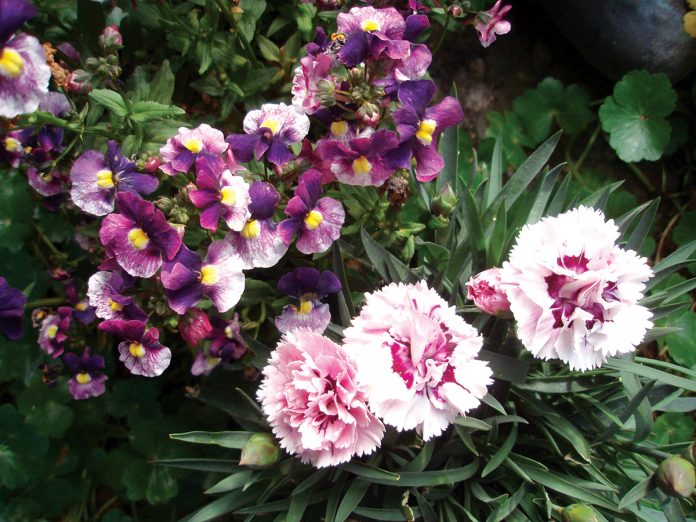A couple of years ago I bought a dwarf butterfly bush and planted it in a pot near my entry. It’s one of the plants that came back from the roots after the fire and it now lives on my deck but in a new pot. I’m not sure if it’s a Buzz Hot Raspberry or a Lo & Behold Pink Microchip but it’s in full bloom and will continue through fall if I keep it deadheaded. The swallowtail butterflies love it and the scent is so sweet and so strong I can smell it through an open window.
Fragrance in flowers is nature’s way of encouraging pollination. Just as it draws you to take a deeper whiff, it lures insects to blossoms hidden by leaves. Some flowers are fragrant only at night and attract night-flying pollinators like moths, while others are more fragrant during the day and attract insects like bees and butterflies. The fragrance itself comes from essential oils called attars that vaporize easily and infuse the air with their scents.
Aroma chemistry is complex and the smell of any flower comes from more than a single chemical compound. These molecules are present in different combinations in different plants, but often they are markedly similar which is why there are irises that smell like grapes and roses that smell like licorice. Our noses can detect those chemical compounds that have a major impact on the aroma. Often a particular molecule will make a large contribution.
Some roses, for instance, derive their scent from rose oxide and others from beta-damascenome or rose ketones. These molecules are detectable by our noses at very, very low concentrations. Carnations, violets, lilies, chrysanthemums, hyacinth- all have their own set of compounds that contribute to their scent.
It’s interesting also that as we become accustomed to the same smell our brain phases it out. A compound called ionones, found in violets and rose oil, can essentially short-circuit our sense of smell, binding to the receptors. This shutdown is only temporary and the ionones can soon be detected again and registered as a new smell.
Place sweet-smelling plants where you can enjoy them throughout the season. The potency of flower scents varies greatly, so consider the strength of a fragrance when deciding where to put a plant. Subtle fragrances such as sweet pea. lemon verbena, scented geranium and chocolate cosmos smell wonderful right outside the back door. Add stronger scents by your deck, pool, spa, dining area or gazebo. Stargazer lilies, jasmine, lilacs, daphne, citrus and peonies will make you want to stay awhile.
Several easy-to-grow shrubs have fragrant flowers as an added bonus. Mexican Orange (choisya ternata) blooms most of the year. Pittosporum eugenoides, tenuifolium and tobira all have tiny blossoms that smell like oranges. too. The tiny flower cluster of Fragrant Olive (osmanthus fragrans) have a delicate apricot fragrance.
Other fragrant plants include California native Philadelphus lewisii (Wild Mock Orange). Calycanthus occidentals (Spice Bush) is native to our Central and Northern California mountains. Their fragrant burgundy flowers smell like red wine. Ribes viburnifolium, carpenteria californica and rosa californica are mildly scented, too.
In spring there may be nothing quite as spectacular as a wisteria vine, loaded with fragrant purple, pink, blue or white flower clusters, covering an arbor or pergola. Pink jasmine is another vigorous vine with intensely fragrant flowers as is Evergreen Clematis.
I can’t leave out the old fashion border carnation or dianthus. Their clove-scented flowers are born in profusion making them a nice addition to the mixed flower border and containers.
The list goes on and includes scented plants such as nemesia, wallflower, Japanese snowbell, hosta, coneflower, vitex, viburnum, nicotiana, phlox, rose, sweet pea, hyacinth, lilac, flowering crabapple, heliotrope, lavender, sweet alyssum, peony, moon flower, southern magnolia.
Be sure to include fragrant plants that release their scent in the evening, especially in the areas of the garden you most frequent after dark. Since the majority of night-scented blossoms have white flowers, these plants also light up the landscape at night. Angel’s Trumpet (brugmansia) is one such plant as is flowering tobacco and night-blooming jessamine.
Plant vines for fragrance in your garden. Evergreen clematis (clematis armandii) bloom with showy white fragrant flower clusters above dark green leaves in the spring. Clematis montana is another variety of clematis that’s covered with vanilla-scented pink flowers in spring also. Carolina jessamine’s fragrant yellow flower clusters appear in masses from late winter into spring.
Ideally, when you’ve finished, your garden will smell as intriguing as an expensive perfume. The top note will be floral—jasmine, honeysuckle, rose. The middle register will be spicy, such as the vanilla of heliotrope or purple petunias or the clove of dianthus. Finally underneath, the tones that give perfumes their vigor, like artemisia, sage and santolina.
Not every inch of the garden needs to be fragrant but a waft or two of fragrance from the right plants can turn a garden from ordinary to enchanting.
Jan Nelson, a landscape designer and California-certified nursery professional, will answer questions about gardening in the Santa Cruz Mountains. Email her at ja******@*ol.com, or visit jannelsonlandscapedesign.com.










